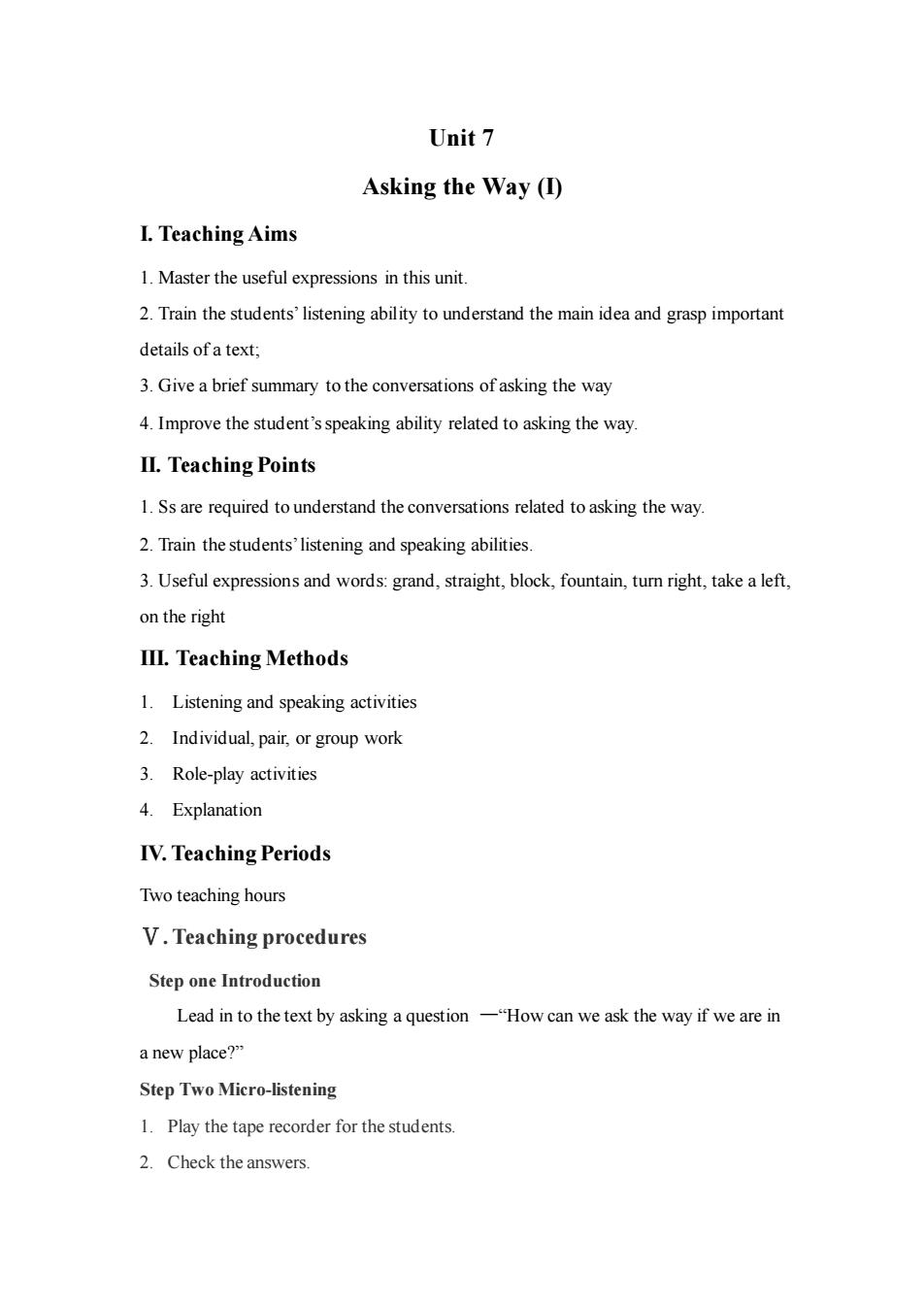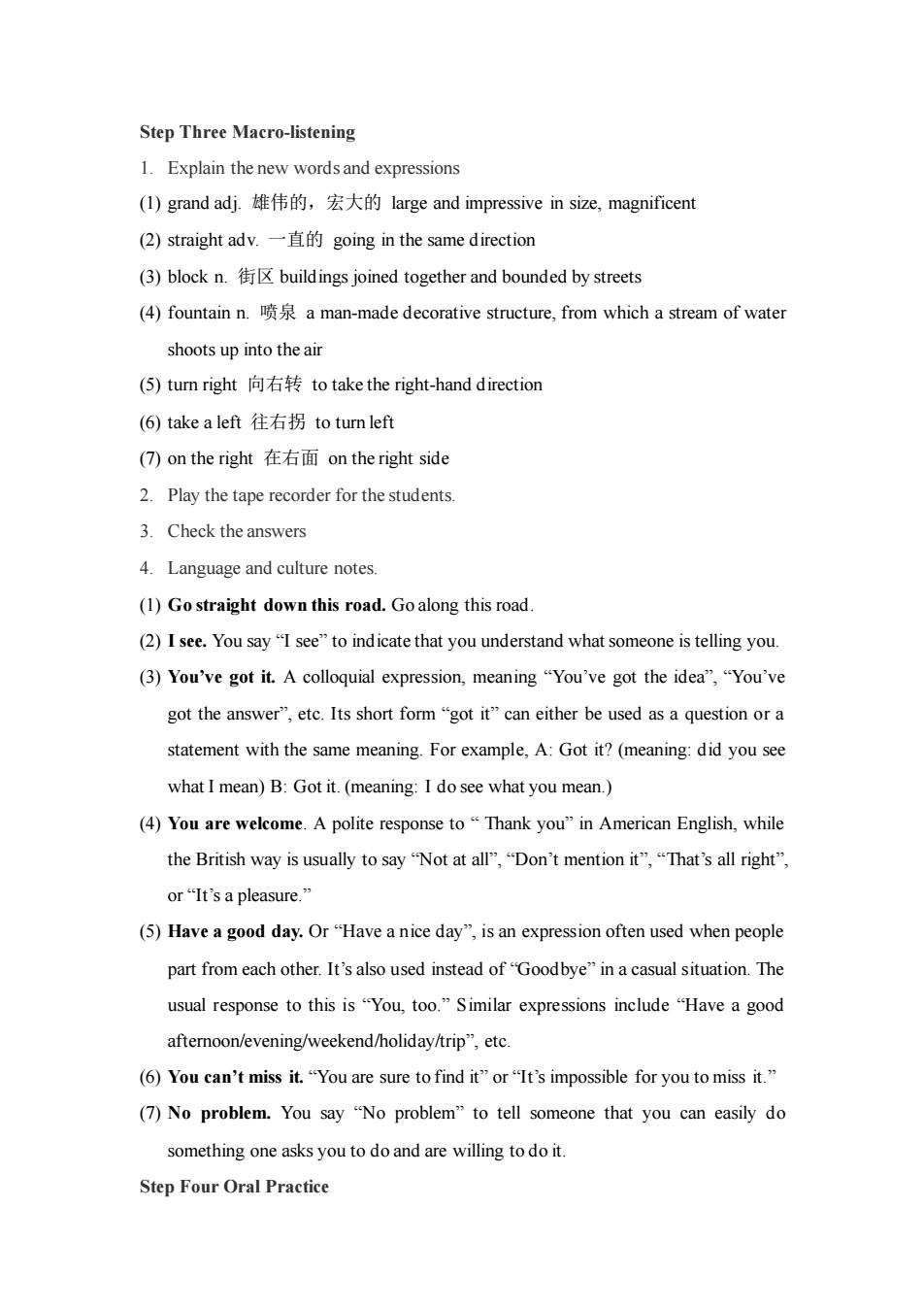
Unit 7 Asking the Way(I) I.Teaching Aims 1.Master the useful expressions in this unit. 2.Train the students'listening ability to understand the main idea and grasp important details ofa text 3.Give a brief summary to the conversations of asking the way 4.Improve the student's speaking ability related to asking the way. II.Teaching Points 1.Ss are required to understand the conversations related to asking the way 2.Train the students'listening and speaking abilities. 3.Useful expressions and words:grand,straight,block,fountain,turn right,take a left, on the right III.Teaching Methods 1.Listening and speaking activities 2.Individual,pair,or group work 3.Role-play activities 4.Explanation IV.Teaching Periods Two teaching hours V.Teaching procedures Step one Introduction Lead in to the text by asking a question -"How can we ask the way if we are in a new place? Step Two Micro-listening 1.Play the tape recorder for the students 2.Check the answers
Unit 7 Asking the Way (I) I. Teaching Aims 1. Master the useful expressions in this unit. 2. Train the students’ listening ability to understand the main idea and grasp important details of a text; 3. Give a brief summary to the conversations of asking the way 4. Improve the student’s speaking ability related to asking the way. II. Teaching Points 1. Ss are required to understand the conversations related to asking the way. 2. Train the students’ listening and speaking abilities. 3. Useful expressions and words: grand, straight, block, fountain, turn right, take a left, on the right III. Teaching Methods 1. Listening and speaking activities 2. Individual, pair, or group work 3. Role-play activities 4. Explanation IV. Teaching Periods Two teaching hours Ⅴ. Teaching procedures Step one Introduction Lead in to the text by asking a question —“How can we ask the way if we are in a new place?” Step Two Micro-listening 1. Play the tape recorder for the students. 2. Check the answers

Step Three Macro-listening 1.Explain the new words and expressions ()grand adj..雄伟的,宏大的large and impressive in size,magnificent (2)straight adv..一直的going in the same direction (3)block n.buildings joined together and bounded by streets (4)fountain n.a man-made decorative structure,from which a stream of water shoots up into the air (⑤)tum right向右转to take the right-hand direction (6)take a left往右拐to turn left (7 on the right在右面on the right side 2.Play the tape recorder for the students. 3.Check the answers 4.Language and culture notes. (1)Go straight down this road.Goalong this road (2)I see.You say"I see"to indicate that you understand what someone is telling you. (3)You've got it.A colloquial expression,meaning "You've got the idea","You've got the answer",etc.Its short form"got it"can either be used as a question or a statement with the same meaning.For example,A:Got it?(meaning:did you see what I mean)B:Got it.(meaning:I do see what you mean.) (4)You are welcome.A polite response to"Thank you"in American English,while the British way is usually to say"Not at all""Don't mention it""That's all right' or"It'sa pleasure. (5)Have a good day.Or"Have a nice day",is an expression often used when people part from each other.It'salso used instead ofGoodbye"in acasual situation.The usual response to this is"You,too."Similar expressions include "Have a good afternoon/evening/weekend/holiday/trip".etc. (6)You can't miss it.“You are sure to find it”or“It's impossible for you to miss it..” (7)No problem.You say "No problem"to tell someone that you can easily do something one asks you to doand are willing to do it. Step Four Oral Practice
Step Three Macro-listening 1. Explain the new words and expressions (1) grand adj. 雄伟的,宏大的 large and impressive in size, magnificent (2) straight adv. 一直的 going in the same direction (3) block n. 街区 buildings joined together and bounded by streets (4) fountain n. 喷泉 a man-made decorative structure, from which a stream of water shoots up into the air (5) turn right 向右转 to take the right-hand direction (6) take a left 往右拐 to turn left (7) on the right 在右面 on the right side 2. Play the tape recorder for the students. 3. Check the answers 4. Language and culture notes. (1) Go straight down this road. Go along this road. (2) I see. You say “I see” to indicate that you understand what someone is telling you. (3) You’ve got it. A colloquial expression, meaning “You’ve got the idea”, “You’ve got the answer”, etc. Its short form “got it” can either be used as a question or a statement with the same meaning. For example, A: Got it? (meaning: did you see what I mean) B: Got it. (meaning: I do see what you mean.) (4) You are welcome. A polite response to “ Thank you” in American English, while the British way is usually to say “Not at all”, “Don’t mention it”, “That’s all right”, or “It’s a pleasure.” (5) Have a good day. Or “Have a nice day”, is an expression often used when people part from each other. It’s also used instead of “Goodbye” in a casual situation. The usual response to this is “You, too.” Similar expressions include “Have a good afternoon/evening/weekend/holiday/trip”, etc. (6) You can’t miss it. “You are sure to find it” or “It’s impossible for you to miss it.” (7) No problem. You say “No problem” to tell someone that you can easily do something one asks you to do and are willing to do it. Step Four Oral Practice

1.Ask the students to do the Exercise of"Making Appropriate Responses"in pairs. 2.Listen to the conversationl,2 again,and finish the Pair Work. Step Five Home Listening Ask the studentsto finish the"Home Listening"after class VI.References 1.《大学英语听说》(学生用书),虞苏美,李慧琴主编,上海:上海外语教有出 版社,2006. 2.《大学英语听说》(教师用书),虞苏美,李慧琴主编,上海:上海外语教育出 版社,2006. 3.An Advanced English Grammar:薄冰主编.北京:高等教育出版社,1996. 4.牛津高阶英汉双解词典(第六版).牛津大学出版社,2004
1. Ask the students to do the Exercise of “Making Appropriate Responses” in pairs. 2. Listen to the conversation1, 2 again, and finish the Pair Work. Step Five Home Listening Ask the students to finish the “Home Listening” after class. VI. References 1.《大学英语听说》(学生用书),虞苏美,李慧琴主编,上海:上海外语教育出 版社,2006. 2.《大学英语听说》(教师用书),虞苏美,李慧琴主编,上海:上海外语教育出 版社,2006. 3. An Advanced English Grammar. 薄冰 主编. 北京:高等教育出版社,1996. 4. 牛津高阶英汉双解词典(第六版). 牛津大学出版社,2004